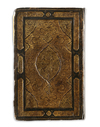Lot 119 MUHAMMAD GHAZALI MASHHADI (D.1572), NAQSH-E BADI, A POEM ON MYSTIC LOVE, SIGNED BY BABA SHAH AL-ISFAHANI, PERSIA, SAFAVID, CIRCA SECOND HALF 16TH CENTURY
A Persian manuscript on gold-sprinkled paper, comprising 43 leaves with 12 lines per page, written in elegant nastaʿlīq script in black ink. The text is arranged in two columns, ruled in green, orange, gold, and blue. Folio 1b features a polychrome and gold headpiece, while folio 25b contains a miniature of Layla and Majnun rendered in watercolor heightened with gold. The manuscript is bound in brown leather with stamped gilt decoration, and doublures adorned with a central medallion and cornerpieces decorated with delicate filigree over a colored ground.
Dimensions: 24 by 14.7 cm.
Catalogue Note: This exceptional manuscript showcases the harmonious and exquisitely balanced hand of the master calligrapher Baba Shah, one of the most esteemed figures at the Safavid court of Shah Tahmasp (r. 1524–1576). The poetic text, a mystical composition, was authored by Baba Shah’s contemporary, the distinguished poet Muhammad Ghazali Mashhadi. A qasida from this very work, dedicated to Shah Tahmasp, appears on folio 13a of the present volume.
Though the biographical details of Baba Shah remain sparse, his artistic legacy is immortalized through his graceful and meticulously composed works. He began his training in calligraphy during his youth under the tutelage of the renowned Mir Ali Harawi (d. 1544), whose influence profoundly shaped his style. At Shah Tahmasp’s court, Baba Shah earned the prestigious title Sadr al-Sudur (“Chief of Chiefs”), attesting to his unrivaled mastery of the nastaʿlīq script.
Muhammad Ghazali Mashhadi (d. 1572), the poet of this manuscript, also served the Safavid court before his exile to India, where he found patronage under the Mughal Emperor Akbar. Though it is likely that Ghazali departed Persia prior to Baba Shah’s emergence at court, his mystical and progressive vision appears to have deeply influenced Baba Shah’s own spiritual and artistic sensibility.
Baba Shah’s journey took him through the cultural epicenters of Isfahan and Baghdad, where he eventually passed away in 1587/88. His surviving works, dated between 977 AH (1569–70 CE) and 994 AH (1586–87 CE), bear witness to his enduring artistic legacy (see: Mehdi Bayani, Ahval va Asar-e Khosh-Nevisan, vol. I, Tehran, 1345 SH, pp. 85–91). Widely recognized as the supreme master of nastaʿlīq, Baba Shah also authored the influential treatise Adab al-Mashq, which outlines the foundational principles of the script alongside its spiritual and aesthetic dimensions. The treatise reveals a contemplative, visionary approach to concentration, steeped in the mystical traditions of Sufism—affirming the inseparable bond between art, devotion, and transcendence (Ernst, 1992, p. 279).







